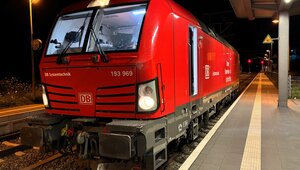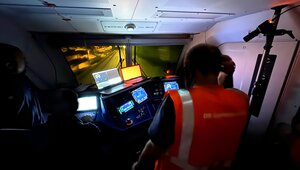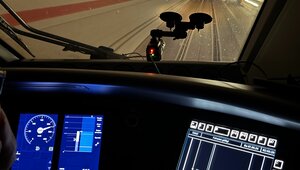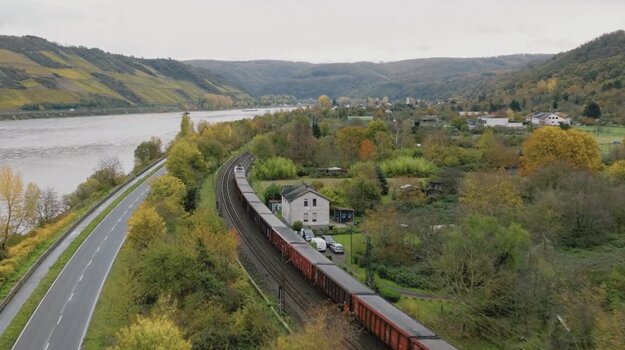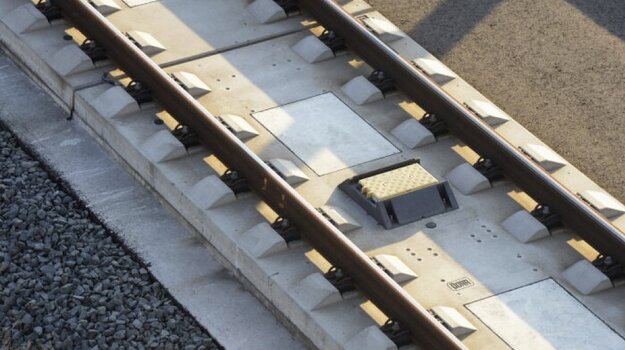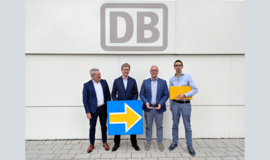
Important commissioning on the Corridor Rhine-Alpine: First radio block centre from manufacturer Hitachi Rail in Germany
Premiere for DB InfraGO AG and Hitachi Rail: During the night of 9 to 10 August, three Radio Block Centres (RBC) were put into operation on the Corridor Rhine-Alpine in Freiburg, Buggingen and Basel, meaning that ETCS Level 2 (L2) is now fully implemented on the approximately 100-kilometre stretch between Gundelfingen and Haltingen. This first application of an ETCS product from Hitachi Rail in Germany marks a decisive step forward. The commissioning of the three RBC is not only an impressive milestone, but also the basis for further ETCS projects in Stuttgart, on the right bank of the Rhine and on other lines, as part of the comprehensive ETCS rollout in Germany.
The three new RBC in Freiburg, Buggingen and Basel, in conjunction with almost 3,400 balises in the track area, control ETCS Level 2 operation on the approximately 100-kilometre stretch of the Corridor Rhine-Alpine between Gundelfingen (north of Freiburg) and Haltingen (Swiss border near Basel). RBC stands for Radio Block Centres and serve as an information interface between the interlocking and the train. This means that each interlocking in this area is assigned to one of the three RBC. The RBC in turn are in contact with the trains via radio.
The first product approval of the RBC by Hitachi Rail in Germany represents a significant turning point, as it forms the basis for further ETCS projects. In addition, with the commissioning of the three RBC, ETCS L2 will be used in Germany for the first time in parallel with the existing intermittent automatic train protection and continuous automatic train control systems. This has the advantage that all trains can continue to run on the line - including those that are not yet equipped with ETCS. For this purpose, hardware and software for ETCS operation and for interaction with the existing systems had to be developed and approved on the basis of the generic specifications of DB InfraGO AG. The system functions of ETCS System Version 2.0 are now available in the three RBC areas.
The successful commissioning of the three RBC is the result of several years of careful preparation. During this time, numerous planning, development and implementation steps were realised properly and on time. Several important milestones were reached: in order to ensure ETCS-capable operation, the interlockings were either adapted or renewed, including in Müllheim, Buggingen, Bad Krozingen, Leutersberg and Denzlingen. Another key factor for progress was the reliable proof of compatibility of the RBC product with the applicable requirements and the adaptation of the system development for ETCS. The approval assessment and release of Hitachi Rail's products represented further decisive steps. In addition, the ETCS-capable control and operating system at the operations centre in Karlsruhe was established. Together with the European Railway Agency (ERA), the notified body (TÜV Rheinland) and the German Federal Railway Authority (EBA), all the necessary steps up to approval were taken.
Immediately before commissioning, the newly installed technology was comprehensively tested. A team of experts consisting of acceptance inspectors, specialist departments and the project team from DB InfraGO AG and Hitachi Rail carried out extensive safety testing and acceptance runs on the section of track in order to demonstrate safe railway operations. Furthermore, compatibility runs were carried out with eight other train series to ensure the compatibility of the ETCS equipment between the train and the track.
The ETCS will now be tested further in the coming months, and full commissioning will then take place depending on the expansion of the Rheintalbahn north of the Katzenberg Tunnel.

"Thanks to the partnership-based cooperation between DB InfraGO AG and Hitachi Rail, the commissioning of the three Hitachi RBC was achieved for the first time in Germany. Thanks to above-average commitment and focussing on the common goals, it was possible to overcome all challenges. Dr. Reiner Behnsch (Head of ETCS and ATO GoA2) and I would like to thank everyone involved," says Ulrich Kohlenberger, Head of the Corridor Rhine-Alpine project.
You can also find this article on LinkedIn.
